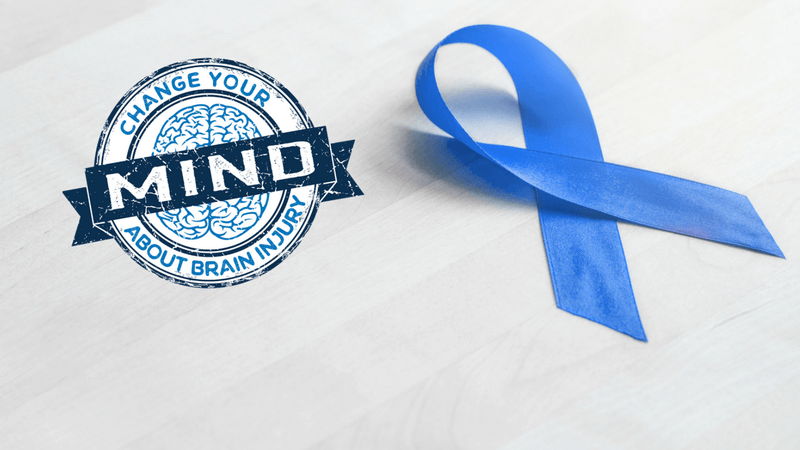
When an injury or illness is validated by visible symptoms, no one questions whether it is real. To do so would be insensitive and rude. As well, when the world around us can see the injury with their own eyes, they are more likely to extend compassion and understanding. For example, if you approached a store entrance on crutches, a stranger might hold the door for you.
Now imagine that you have an injury that no one can see. On the outside, you look perfectly healthy and capable. Yet inside, you struggle to remember your birth year. Headaches, mental fatigue and restless nights are a normal part of your life. On certain days, sheer exhaustion and overwhelming gloom drive you to isolate from others for no apparent reason. Still, even those who are closest to you insist that you seem “fine.” They have no idea how hard you are trying just to keep up.
This is just a glimpse into what is reality for many brain injury survivors.
Brain Injury Awareness Month
Brain injury is one of the four hidden disabilities. To that end, it’s suitable that March has been designated as Brain Injury Awareness Month. For more than 30 years, the Brain Injury Association of America (BIAA) has spearheaded America in observing this month with three goals:
- De-stigmatizing brain injury through outreach within the brain injury community
- Empowering brain injury survivors and their caregivers
- Promoting the many types of support available to those living with brain injury
The topic of brain injury is clouded with myths and misunderstandings. While most people are well-intentioned, many are sadly misinformed about the “invisible disability,” mostly by the media and entertainment industries. The BIAA seeks to remedy this by raising awareness, supporting brain injury survivors and providing education about the disability, which affects an estimated 5.3 million people every year.

Prevalence & Causes of Brain Injury
Brain injury refers to any damage done by insult to the brain, while traumatic brain injury (TBI) is any injury that disrupts the function of the brain (Brain Injury Alliance). For a brief glance into the seriousness of the matter, here are a few quick stats:
- Approximately 1.5 million Americans get TBI’s every year
- In Connecticut alone, 36,000 hospitalizations, ED visits and deaths occur from TBI each year
- Adolescents, young adults and people over 75 are at the highest risk
- Men are twice more likely to get a TBI
Car accidents are the leading cause of TBI, more than violence and fall-related causes.
Not only are brain injuries highly common, perhaps an equally serious concern is that they are often under diagnosed. This is due in large part to the fact that the long-term effects of brain injury are not immediately apparent.
In Connecticut alone, 36,000 hospitalizations, ED visits and deaths occur from TBI each year.
With thousands of brain injuries occurring each day, ask yourself: do I know how to spot the signs of a brain injury? Familiarizing yourself with a few tips could be critical in a time of need.
Signs of Concussion
Just as with being able to recognize the signs of a heart attack, knowing what to look for after a head injury could greatly impact the treatment a survivor receives, their chances of recovery and could even save their life in certain cases.
Concussions are one of the most common types of brain injury. Pay close attention to the following symptoms after trauma to the head and report them to a medical professional immediately:
- Headache or “pressure” in the head
- Temporary unconsciousness
- Brain fog, confusion
- Amnesia about the traumatic event
- Dizziness or “seeing stars”
- Ringing in the ears
- Nausea
- Vomiting
- Slurred speech
- Delayed response to questions
- Appearing dazed
- Fatigue
These indicators could show right away, yet others might take hours or even days to surface, such as:
- Trouble concentrating
- Irritability or personality changes
- Sensitivity to light and noise
- Sleep disruptions
- Depression

Traumatic brain injury in children is slightly more difficult to detect since children aren’t always able to describe how they feel. In this case, watch for excessive crying, fatigue, a lack of interest in activities or irritability.
Common Misconceptions About Brain Injury
For brain injury survivors, dealing with an injury no one can see and even fewer understand can become quickly discouraging. To say the least, the disability is highly misunderstood. It is no wonder that survivors face a barrage of misunderstandings about their condition.
One of the most tragic mistakes to make is confusing apathy with laziness in a brain injury survivor. Apathy - a lack of interest, motivation or emotion - occurs in at least a quarter of survivors and has been connected with acute brain damage.
Not only is mistaking a survivor’s apathy for laziness poor judgment, a careless comment about it can actually set them back in their post-injury progress. Understanding the difference is critical, even for the sufferer, who might be plagued by unrealistic self-imposed expectations about their recovery.
What Not to Say to Someone With a Brain Injury
You may be surprised to learn how powerful your words can be in either helping or hurting a person dealing with brain injury. Keep in mind that the two main struggles for survivors are regaining their independence and sense of control. With that, here are a few things you should not say to a person with a brain injury:
“Let me do that for you.”
Well-meaning loved ones might be tempted to perform simple tasks that have now become painstaking for a survivor. Avoid the temptation to intervene, regardless of how much easier or faster it will make things. The exception to this is when the act puts your loved one at risk, such as making important decisions or attempting to drive too soon after the injury.
“You seem fine to me.”
Your loved one does not feel fine, even if he or she may look it. It might seem positive to say this, though it will more than likely come off as uncaring and hurtful to a brain injury survivor. A seemingly harmless statement like this can minimize the internal conflict, heartache and emotions that are commonly experienced by survivors.
On the contrary, there are ways that you can encourage a brain injury survivor and aid in their healing process.
Ways to Support Brain Injury Survivors
Below are just a few ways to best support a person living with a brain injury:
- DO be patient. This applies to many of the cognitive effects of a brain injury, including memory loss and relearning everyday skills.
- DO be a good listener. Resist the urge to admonish, correct or “fix” your loved one, who is likely trying to get a handle on their emotions. Instead, be a listening ear and tell them their feelings matter. At times, your availability will be the strongest support you can offer.
- DO acknowledge their courage and strength. Your loved one is trying their best and might be a little hard on him or herself. Affirm them by verbalizing how strong and brave they are for trying and making it through a tough experience.

Get Involved With Brain Injury Awareness
Perhaps the best way to support someone living with a brain injury - whether it is a loved one or acquaintance - is to be informed about the disability. This takes minimal time, and this article is a good start.
Easy ways to show you care can be:
- Sharing this blog
- Becoming an advocate with BIAA
- Reading and sharing brain injury stories, including your own
- Making a donation to the BIAA
You can also check the BIAA website for more ways to get involved with this month’s campaign and use the hashtag #ChangeYourMind on social media.
Of course, if you or a loved one recently sustained a brain injury that you believe might have been preventable, reach out to The Flood Law Firm at (877) 987-9529 with any questions. We are available to help you understand your options moving forward.
